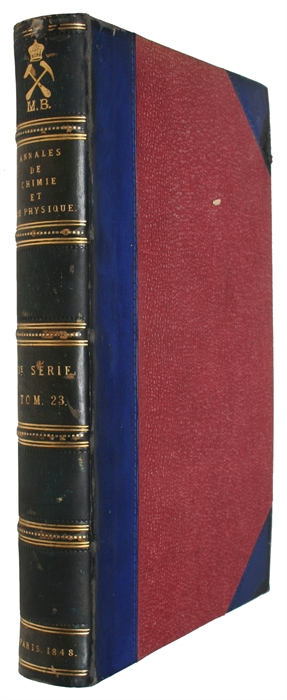PASTEUR, LOUIS. - INTRODUCING A NEW KIND OF ISOMORPHISM.
Recherches sur le Dimorphisme; (Memoire lu à l'Academie des Sciences, dans la séance du 20 mars 1848). (+) Note sur un travail de M. Laurent intitulé: Sur l'isomorphisme et sur les types cristallins.
Paris, Victor Masson, Imprimerie de Bachelier, 1848. 8vo. Contemp. hcalf, raised bands, gilt spine. Very light wear along edges. Small stamps on verso of titlepage and on verso of plate. In "Annales de Chimie et de Physique", 3me Series - Tome XXIII. 512 pp. a. 4 plates. (The entire volume offered). Pasteur's papers: pp. 267-294 a. pp. 294-295, 1 double-page folded engraved plate. A few marginal brownspots to P.'s paper. Otherwise fine and clean.
First full exposition of Pasteur's first revolutionary paper on the discovery of "molecular assymetry" - also constituting his first published scientific paper. In order to secure priority, Pasteur announced his discoveries first in its preliminary form in a short paper of 4 pages in "Recherches sur le dimorphisme", Comptes rendus hebdomadaires des séances de l' Académie des Sciences, 20 mars 1848, XXVI, pp. 353-355. In the offered form it is the first full treatment of his discoveries.
"Pasteur came to the conclusion, on one hand, that all tartrates could be regarded as mutually isomorphic, but at the same time - based on Mitscherlich's work - that the sodium ammonium salts of both the tartaric and racemic acids also crystallized isomorphically, which in turn suggested that all racemic and tartaric salts would crystallice identically. An they do crystallice identically, albeit in a very special way Half the crystals of the racemic salts are characterized by a mirror-inverted form."(Hans-Werner Schütt in "Eilhard Mitscherlich").
"Another discovery of great importence was made by Pasteur. In 1844 Mitscherlich had stated that the crystals of sodium ammonium tartrate and sodium ammonium racemate were identical, although solutions of the former were found to be active but those of the latter were inactive. Since this statement was contrary to his views on the relation between crystalline form and optical activity, Pasteur examined these salts and found, it is true, that the crystals of the tartrate resembled the other tartrates which he had examined i possessing hemihedral faces arranges in a similar manner. The crystals which was obtained from a solution of the inactive racemate, at the ordinary temperature, were also found, contrary to expectation, to have hmihedral faces...."(Alexander Findley in "A Hundred years of Chemistry", p.59-60).
It is related that Pasteur, on making this discovery, rushed from his laboratory and, meeting the lecture assistant in physicss, embraced him, exclaming: "I have just made a great discovery! I have separated the sodium ammonium paratartrate into two salts of opposite action on the plane polarisation of light. The dextro-salt is in all rspects identical with the dextro-tartrate. I am so happy and overcome by suchnervous excitement that I am unable to place my eye again to the polariization apparatus.".
Among other importent chemical papers the volume contains Gay-Lussac: Mémoire sur L'Eau Régale. Pp. 203-229.
Order-nr.: 43077

